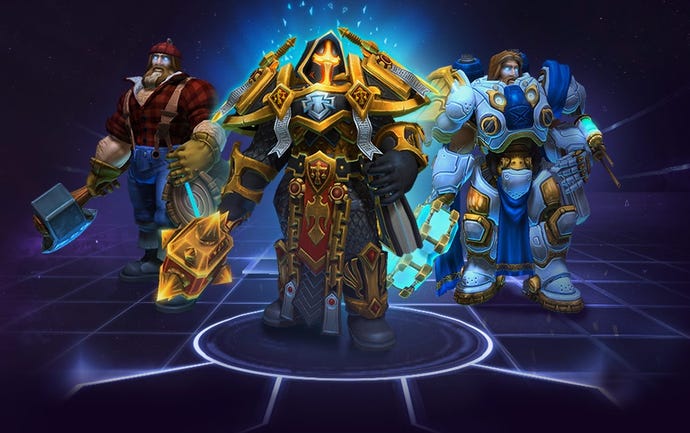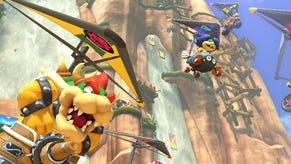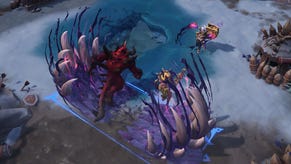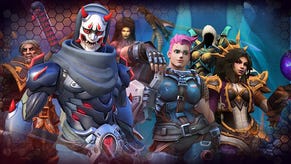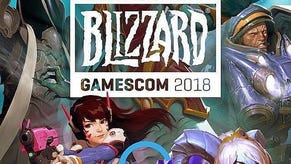Heroes of the Storm: how to brawl your way to victory
From soaking XP to handling BM - Rich Stanton's advice on how to win in Blizzard's ace new Moba.
Blizzard's Heroes of the Storm is a cracker – I'm hooked. It's a different beast entirely to other Mobas and one of the big changes is streamlining a lot of their 'classic' mechanics. This means a lot of people describe HotS as a simple game – which isn't quite true. There's a lot less 'stuff' to learn, but the accessibility hides a lot of depth. So if you're curious this is how the game's basic mechanics work, and their not-so-obvious ripples across matches.
The Foundation
Common elements for every match include each team's core and minions, various lanes fortified with defensive structures, and watchtowers. Minions spawn in waves from the core and head across each lane towards the enemy core.
Defensive fortifications get stronger the closer you get to the core, with the final barrier being big castles called 'Keeps' – once enemy Keeps are destroyed, your minions pushing that lane will begin to spawn with powerful catapult troops. Over time fortifications gradually run out of ammo from killing minions, and your hero's damage against them will increase – but beware! Attacking any structure without minions around is asking for trouble.
It sounds a bit pseuds-corner, but the best way to think of a HotS map is like a miniature ecosystem. If you leave it be then the minion waves will fight to a standstill, but once heroes start interfering all over the shop then that natural flow gets disrupted. Tiny advantages will snowball, and holes in your defence will be inexorably widened.
Soaking XP
HotS shares experience across the team, and you'll hear the term 'soaking XP'. This refers to sitting in one of the map's lanes near enemy minions, and collecting XP as they die.
Simple enough, but a tip for melee players: you don't need to actually fight. Ranged characters one-on-one will generally have an advantage and it can be annoying as hell to watch them rinse your minion waves while you have to hang back out of range – but you don't need to do damage. As long as enemy minions are dying in proximity, and your minions will be taking care of that to some extent, you're soaking XP.
Mercs and map flow
Mercs are neutral minions that are dotted around each map, in different configurations for each one. There are three types: Siege Giants (easy camps), Bruisers (hard camps), and Bosses. Don't confuse these with either the bog-standard minions for each team, or the objective minions that certain maps throw up.
What's unique about Merc camps is that, once you've beaten them in a fight, you can 'capture' them – at which point they'll head down a set route and bash away at your enemy's forts and minions. A few minutes later the camp will respawn, and as players level so too do Mercs become more effective. Tiny advantages like Siege Giants, if left uncontested long enough, will push far through the enemy's defences.
The Boss, only present on a handful of maps, is the exception. Bosses are huge, tanky minions that usually require most of a team to take down, but are guaranteed to do serious damage to enemy structures and the core. Because of this the Boss locations are often prime spots for ambushes and team fights – there's nothing better than smashing into another team weakened from fighting the Boss, and stealing it from under their noses. And vice-versa.
The long and short of it is you should capture Merc camps and, if the opportunity is there, support them. Mercs represent a small advantage that, if used at the right time, can snowball into a big one.
Two caveats to all of the above. The first is that, unless you're playing specialist Merc heroes, you'll usually need the help of your allies to capture Mercs efficiently (ping the camps with 'G'). The second is that the real key to using Mercs well is timing. When a map objective goes live, capturing Mercs is generally a bad move. But if you'd captured those same Mercs beforehand, they'd be pushing while your opponents are focusing on the objective.
Location Location Location
A defining part of HotS is the variety of objective-based maps on which the matches take place (other Mobas tend to use a single map). There are currently five maps, each of which has a bespoke layout, different number of lanes, and central objective that periodically becomes the focus.
These objectives are incredibly powerful. Ignoring them means your team will lose, almost without exception. Though each map's objective differs in what it requires – from collecting coins to controlling pressure pads – they all require teams to work together.
Objectives are announced with a countdown plus audio and visual cues, so there's never a reason to miss them. Prioritise them over everything to start off with. When you get more used to HotS there are times when it's better to let an objective fall to the enemy in order to secure some other advantage, but generally they're too powerful to ignore.
Fight on-screen, move with the minimap
This is particularly important when things get more hectic. Obviously when you're in a fight with other heroes that's where your focus should be – dodging attacks, landing your heroic abilities, and generally pwning up the noobs. But this is only one side of HotS, albeit the most fun.
The fog-of-war in HotS lets you see whatever allied units can see – little red or blue dots for minions, skulls for mercs, and mini-portraits of heroes in vision. This information changes constantly, so you have to get into the habit of glancing at it all the time. It's the difference between helping teammates take down or escape enemy heroes, and being a few seconds too late. Generally whenever I'm moving any great distance I'm looking at the map rather than my hero, checking out what's happening at the hotspots and how long any merc timers have left. If you see an enemy nearby or god forbid get jumped then hit space to put the camera back on your hero and focus on combat.
Level 10's a klaxon
When a team hits level 10 they unlock heroic abilities. These are often the deciding factor in team fights and smaller engagements – so if your team hits level 10 first you should be doing everything possible to provoke the other team into a big fight. Conversely if the enemy team hits 10 first, then back off and soak up some XP until you can re-engage on a level playing field.
Keep Tab on your enemies
Press 'tab' to see what talents your allies and enemies have chosen during a game. At first it's confusing, but mousing over any icon explains what it is, and what else are you going to do with that respawn downtime? Knowing what your enemies are capable of is never not useful.
Should you buy the Founder's Pack?
HotS is currently in closed beta, so not technically finished, but it is clearly very close to being the final product – because Blizzard now allows you to buy access to the beta with the £30 Founder's Pack. Is it worth it?
Let me preface this by saying I think HotS is brilliant and I play it an awful lot. I wouldn't buy the Founder's Pack unless money's no object. £30 gets you access and three heroes plus some skins and a mount. When HotS releases it will be free-to-play, and the game's internal economy reflects this – buying heroes with in-game gold will take a long time, and they're also very expensive to buy with cash (up to £6.50 each).
Basically you're buying access to a F2P experience with a slow grinding curve. The financial comparison I'd make is with the Nexus Pack which, for roughly £30, offers eight heroes plus a bunch of skins and mounts. Even then you could call that expensive. So, unless you absolutely can't wait, skip the Founder's Pack and you won't regret it.
BM-oba
Any competitive game unfortunately attracts a minority of what we in the business call "assholes" – other players who will bad-manner (BM) you during and after games for a million perceived mistakes. Mobas are a fertile breeding ground for this behaviour, probably because success is always co-dependent.
Don't pay attention when teammates get on your back about playing HotS "wrong," because most don't know much about the game. One of my favourite characters is Gazlowe, a merc-focused hero, and nearly every time I play him someone mouths off about how crap he is. My win rate with Gazlowe's off the charts, and he looks awesome to boot, so they're just mooing idiots.
Almost everything you learn in a game like HotS is through experimentation. By all means try out the recommended builds, read the tier lists, watch the pro videos and so on – but don't take them as gospel. A huge part of the enjoyment in HotS is finding all the cool tricks and synergies Blizzard has invested each character's talent tree with, and surprising yourself with strange combinations. Never be scared of losing, and you're well on the way to winning.
Next time Rich will go into more detail on Heroes, their classes, and some effective standard builds for the starting characters.
